-

In his 1921 report to the Board of Trustees, President Riggs expressed satisfaction with the new Department of Student Affairs and conditions in the mess hall.
-

Professor D. H. Henry, a widely popular teacher at Clemson, was tasked as the first Director of the Department of Student Affairs. His responsibilities included monitoring barracks, mess hall, and laundry conditions and to be a general advocate for students.
-

An article in "The Clemson Alumnus" described the new Department of Student Affairs, which was to be overseen by a widely popular professor, Dr. D. H. Henry.
-

In a two-day meeting during the summer of 1920, the Board of Trustees made substantial revisions to by-laws concerning the Disciplinary Committee, including instituting public trials.
-

In a two-day meeting during the summer of 1920, the Board of Trustees officially approved the creation of a Department of Student Affairs.
-

President Riggs offered his reflection of the 1920 walkout. He placed particular emphasis on the notion that college life had changed in the years following World War I. He insists Clemson had operated as an institution "for boys;" however, the Great War had turned many of Clemson's students into men. This disparity was the root cause of the walkout in Riggs' view.
-
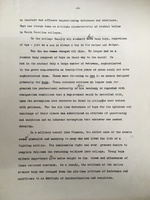
President Riggs offered his reflection of the 1920 walkout. He placed particular emphasis on the notion that college life had changed in the years following World War I. He insists Clemson had operated as an institution "for boys;" however, the Great War had turned many of Clemson's students into men. This disparity was the root cause of the walkout in Riggs' view.
-

President Riggs offered his reflection of the 1920 walkout. He placed particular emphasis on the notion that college life had changed in the years following World War I. He insists Clemson had operated as an institution "for boys;" however, the Great War had turned many of Clemson's students into men. This disparity was the root cause of the walkout in Riggs' view.
-

In the days following the Board of Trustees' investigation, newspapers around the state reported on the Board's findings. The Board sided with the school administrators, but stated their intention to concede on some of the students' demands.
-

President Riggs received numerous correspondence expressing support. This letter is notable as it was sent from W. S. Currell, president of Clemson's peer institution, the University of South Carolina.
-
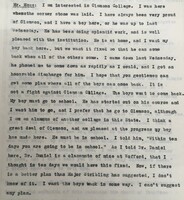
Several parents testified during the Board of Trustees' investigation. Here, Mr. Moss indicates that his son's desire to return to Clemson and seems to believe that his son was motivated to leave campus due to peer pressure.
-
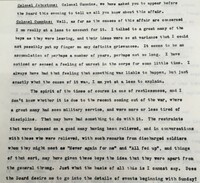
The Commandant of the Corps, Lt. Col. Cummins, testified during the Board of Trustees' investigation. He stated his belief that the walkout was due to postwar angst.
-
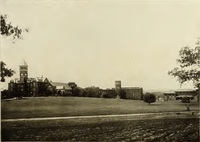
A photograph of "Main Hall" at Clemson College, taken from the 1920 edition of "Taps," the school yearbook.
-

The freshman and sophomore classes drafted a formal petition with several demands including improved mess hall conditions, revisions to the Disciplinary Committee, and reinstatement without punishment of all walkout participants.
-
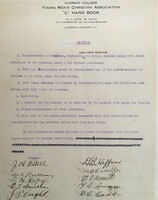
The freshman and sophomore classes drafted a formal petition with several demands including improved mess hall conditions, revisions to the Disciplinary Committee, and reinstatement without punishment of all walkout participants.
-

Cadet Cullum testified during the Board of Trustees' investigation. One of the most prominent features of his testimony was his imparting of student demands, including the institution of public trial for disciplined students.
-

President Riggs submitted a Special Report to the Board of Trustees following the walkout. In the report, Riggs stated that his resignation was "perpetually before them." Riggs' resignation offer was declined.
-

President Riggs submitted a Special Report to the Board of Trustees following the walkout. In the report, Riggs stated that his resignation was "perpetually before them." Riggs' resignation offer was declined.
-

Letters from parents flooded in to President Riggs expressing dismay at the actions of the students. As in this letter, many parents implored for their student to be reinstated and argued that their student was purely motivated by peer pressure.
-

President Riggs received numerous correspondence from around the country following the walkout. In this notable correspondence, a supporter blames the walkout on "anarchism" and "Bolshevism."
-

President Riggs' initial report immediately following the walkout by the freshman and sophomore classes.
-

President Riggs' initial report immediately following the walkout by the freshman and sophomore classes.
-

A letter sent by President Riggs to parents notifying them of a "general holiday" in order to ease tensions from the walkout.
-

A portrait of Cadet Thomas Crosland from the 1922 edition of "Taps," the Clemson yearbook. In the days leading up to the 1920 student walkout, Crosland faced disciplinary action for allegedly shouting "Bolsheviki" on campus.
-

Companies of Clemson ROTC cadets march in formation on campus. Image displayed in the 1920 edition of "Taps," the school yearbook.
























